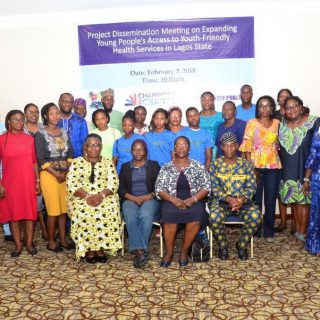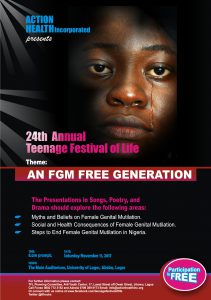Report by Dolapo Adefioye
The International Day against Drug Abuse is day the world is alerted to the threats posed by drug abuse to individuals, families and the society as a whole. Therefore, the drug issue, the promotion and enhancement of drug abuse reduction particularly by young people topped the agenda of Action Health Incorporated on Friday, June 26th, 1998.
The organization, targeted young people by organizing an enter-educate session in its Ifako based Youth Center for representatives of twenty Secondary Schools in Lagos State. The theme for the day was “Youths Uniting against Drug Abuse”. The purpose of the session was to provide information to the young and vulnerable citizens of the country in order for them to be aware of the advantages of abstaining from drug use.
According to Mrs. Ngozi Madubike of the National Drug Law Enforcement Agency (NDLEA) who was the key resource person at the occasion, many of the patients admitted into mental institutions in Nigeria fall within 21-30 years of age, thus reiterating the profile of drug abusers as being adolescents and youths adults.
She stated that the youths are an important segment of the Nigerian society because according to her, they are gullible, impressionable and vulnerable to fads, fashion and subculture norms; they mirror the past and reflect the future of any society and; they constitute almost a quarter of Nigerian population.
These are major facts that have tremendous implication for the development of the young people and the nation as a whole.
Mrs. Madubike gave a brief background to common drugs that are abused in Nigeria. Alcohol was rated as the most commonly abused drug especially among students as they often perceive it as ‘low-risk’ or ‘no-risk’ to them. Tobacco which contains nicotine, a chemical used for the production of insecticide is also commonly abused by young people.
The resultant effects are numerous because contrary to widely held beliefs, alcohol is a depressant and once in the system, depresses the central nervous system and practically slows down every organ of the body making it difficult to react to stimuli and an inability to store information. Tobacco, on the other hand, leads to increased heart rate, difficulty in breathing, destroys the smell and taste buds and leads to cancer of the mouth, throat and lungs.
Marijuana is one of the drugs that constitute a lot of problems to the health of young people as it contains several chemicals. Tetrahydrocannabiol (THC) stays in the body for 30 to 45 days following the smoking of a single “joint”. THC is also stored in the reproductive system. Regular use of marijuana causes lowered levels of the male hormone testosterone, causing low sperm and in abusers, an inability to function sexually. In females, the level of the testosterone increases with male sexual characteristics such as hair on chest, face, flattening of the buttocks and chest, and can interrupt the normal menstrual cycle along with the female reproductive ability.
Other drugs abused by young people although not seen as drugs are coffee, tea and kola nut. They however contain caffeine, a stimulant harmful to the body. Caffeine is especially known to cause insomnia (sleeplessness), sweating, restlessness and paranoia. Consequences of drug abuse include trembling, fatigue, loss of or increase in appetite, nervous breakdown, euphoria, disconnection from reality, anxiety, increased number of mentally ill youths, increased cult activities etc.
A number of reasons were given for the use of psychoactive drugs by youths in schools. These include curiosity, experimentation, peer group influence, parental drug subculture, the need to facilitate reading and to feel at ease, emotional and psycho-social stresses such as anxiety, frustration, depression, availability of drugs, influence of advertisements, the pressure to succeed in academic work and to feel happy.
The support of young people was enlisted in the control, prevention and elimination of the drug problem amongst them. An ex-student of Igbobi College, Yaba, Mr. Sylvester Emope, enjoined his peer’s tom say “No” when approached or when being cajoled to join the group of drug takers. He told participants that once they start taking drugs, there is the likelihood of their becoming dependent, and they may face ejection from school, become drop outs and nobody will want to associate with them, least of all, would-be employers. And that once they are denied employment, they are likely to turn to crime in order to stay alive.
Mrs. Madubike added that other ways that young people can fight the drug scourge is by giving positive normative and moral examples to fellow youths, speaking against drug use, joining drug-free clubs starting an activity that provides alternative use of time to drug use, promoting drug-free life style, encouraging friends who have drug problems to seek help and reporting drug paddlers to school authorities.
The strategies which the participants proposed could be used to solve the emerging drug problem included: educating the young and the old, having stiffer penalties put in the laws enacted by the government, testing for the use of drugs such as alcohol, providing treatment programs with counseling. It is also important that youths should be shown adequate ways of coping and dealing with stresses and failures.
Many of the young people stated that they had learnt a lot from the day’s activities which included a drama presentation on the use of drugs and its negative effects on goal attainment, songs and a poem on the effects of drug use. The program also included an exhibition of books and materials by Action Health Incorporated and the National Drug Law Agency.
The Project Director of Action Health Incorporated, Mrs. ‘Nike Esiet, thanked the PTA members, teachers, media practitioners and the resource person from NDLEA for taking time to be with the young people at the event.
She also expressed her appreciation to the United Nations International Drug Control Program (UNDCP) for providing the educational materials and publicity posters used for the Day’s activity.







You must be logged in to post a comment.